In the United States, up to 600,000 people are reported missing each year. This is according to the National Missing and Unidentified Persons System (NamUs). It shows how big the problem is and why we need to find missing people and help their families.
NamUs is a key player in solving missing persons cases. It helps investigators and the public by matching missing people with unidentified remains. This way, NamUs gives answers to families who are still waiting for news.
Missing persons cases happen everywhere, from national parks to cities. Finding them is hard because of the different challenges they face. Important details like age, physical look, and last known location help in the search. Law enforcement, search teams, and the community all play a big role in solving these cases.
Understanding the Scale of Missing Persons in America
The issue of missing persons in the United States is a big challenge. In 2022, the National Crime Information Center (NCIC) reported 521,705 missing person entries. Sadly, almost 91% of these were children, showing how common child disappearances are.
Long-term missing cases are especially hard for investigators and families. There are about 89,000 active missing person cases at any time. Many of these cases go on for years, causing deep emotional and financial burdens on families.
The Magnitude of Unidentified Remains
The missing persons crisis in America is huge. In 2018, over 11,000 unidentified human remains were in medical examiner offices. Sadly, only 6,000 of these cases were in the FBI’s database, making it hard to find matches.
Challenges for Law Enforcement
Law enforcement faces big challenges with missing persons cases. Small police departments often lack the resources to handle these cases well. Some places also don’t know about their state’s missing persons clearinghouse or federal databases, making it harder to solve cases.
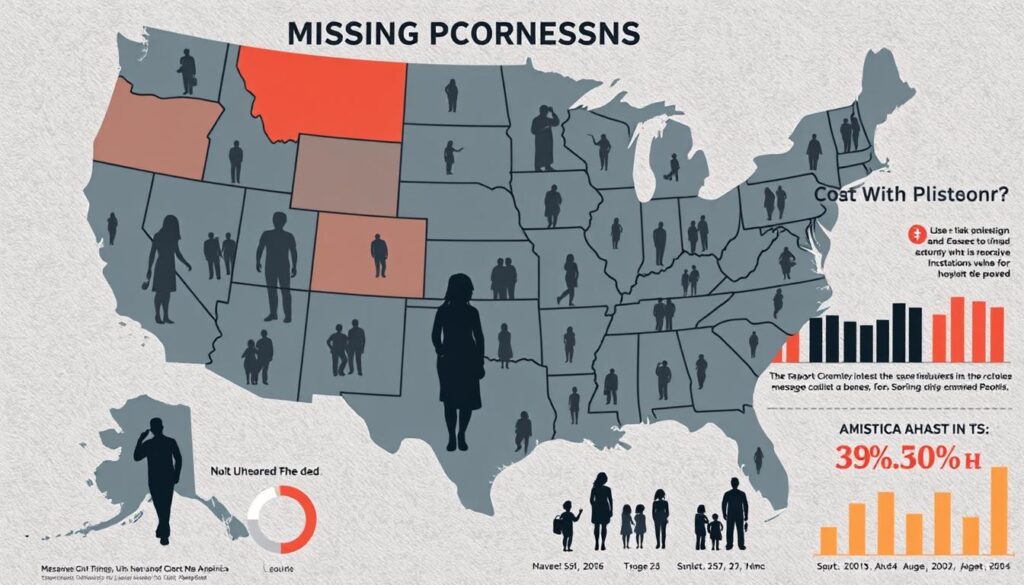

To tackle the missing persons crisis, we need a team effort. We need more resources, training, and coordination between law enforcement, medical experts, and the public. By working together, we can solve more cases and help families find closure.
Immediate Steps When Someone Disappears
When a loved one goes missing, acting fast is key. The first 72 hours are critical for finding them safe. It’s important to report it quickly, as police might not act fast if there’s no sign of trouble.
- Contact the police right away and give them all the details you have. This includes photos, contact lists, and where they last were seen.
- Also, talk to the missing person’s friends, coworkers, and doctors. They might know something important.
- For missing kids or teens, police must act fast. They have to add the report to the FBI’s database within two hours.
Media and social media are big in finding missing people. Families should work with police and use these tools to help find their loved ones.
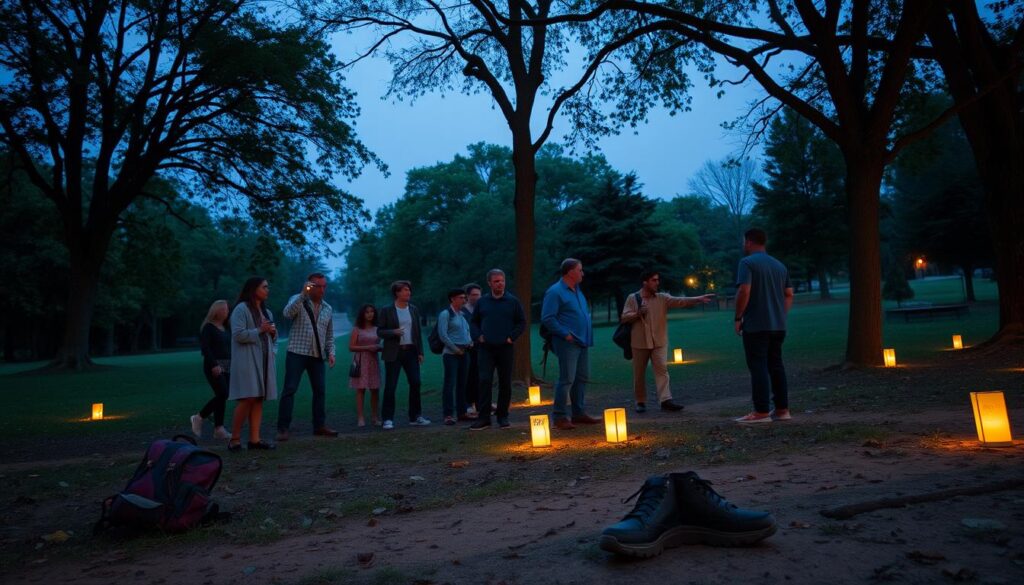

Every minute is crucial in missing persons cases. Quick action and teamwork with law enforcement and the community can lead to a safe return.
The Role of Law Enforcement in Missing Persons Cases
Law enforcement is key in missing persons cases. When someone goes missing, the first thing to do is file a police report. This report should include the missing person’s details and where they were last seen. If the missing person has mental health issues, mention this to help speed up the search.
After the report is filed, the police add it to the National Crime Information Center (NCIC) database. This database helps share information across the country. It’s important to work closely with the investigators. They will lead the search and keep track of all updates.
Investigative Strategies
Here are some common steps in missing persons cases:
- Searching the missing person’s home and the area where they were last seen
- Checking local hospitals, mobile phone providers, financial institutions, and social media accounts
- Conducting door-to-door inquiries and reviewing CCTV footage
- Interviewing acquaintances and coordinating media coverage
- Involving Search and Rescue personnel for specialized searches, if necessary
These investigations, along with gathering forensic evidence and witness accounts, are vital. They help find missing people and figure out what happened to them.
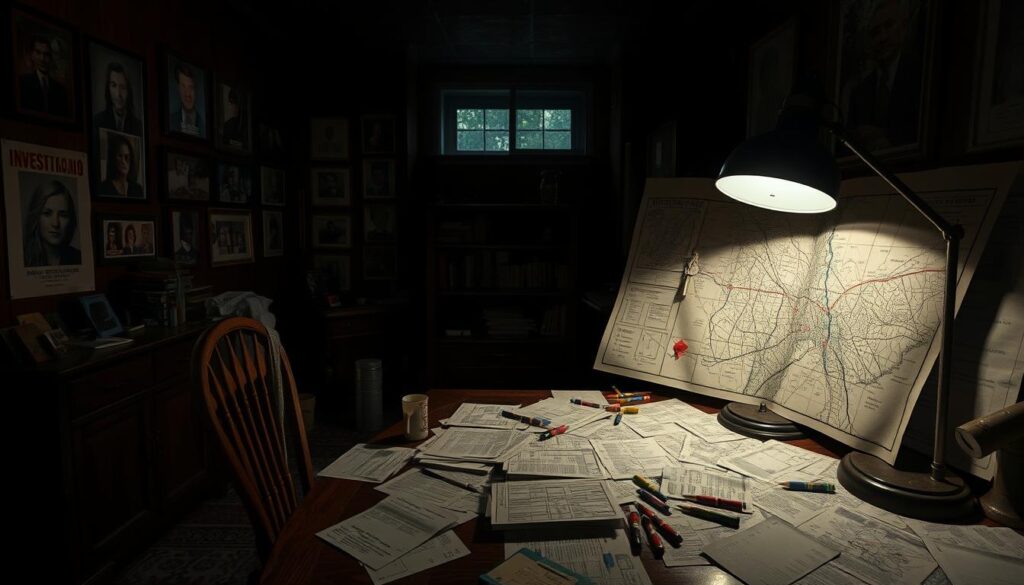

“The first 24 hours of a missing person’s report are critical, and law enforcement takes the lead in managing and investigating the case.”
National Missing and Unidentified Persons System (NamUs)
The National Missing and Unidentified Persons System (NamUs) is a key resource for many. It helps families, law enforcement, and medical examiners. Users can input data on missing persons, like physical details and last seen locations.
NamUs offers free forensic services. It matches missing persons with unidentified remains. This helps solve cold cases and bring closure to families.
Launched in 2007, NamUs has grown to be essential in missing persons cases. It provides free forensic help, like DNA analysis and fingerprint checks. This aid is crucial for identifying individuals.
- NamUs aims to close gaps in missing indigenous persons data. It ensures tribal law enforcement can use the system to solve cases.
- States like New York and Tennessee have laws requiring agencies to list missing persons on NamUs.
- In 2018, NamUs 2.0 was launched. It improved the system’s features and user experience.
The National Institute of Justice supports NamUs with funding. This helps use DNA technology in criminal justice, including for missing persons. The Center for Human Identification at the University of North Texas also aids NamUs in DNA services.
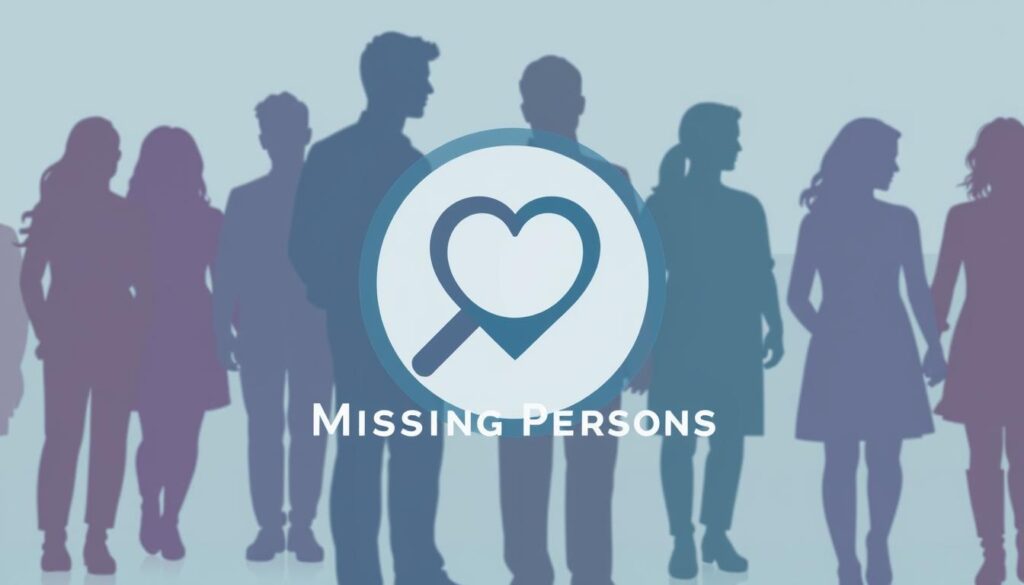

“NamUs is a critical resource for law enforcement, medical examiners, and families searching for their loved ones. It has helped resolve numerous unresolved disappearances and cold cases by facilitating the identification of unidentified remains.”
NamUs’s database and forensic services are vital. They help bring justice and closure to families of missing persons.
Digital Search Strategies and Social Media Resources
Digital tools and social media are key in finding missing loved ones. They help families reach out and gather support. This way, they can make their search efforts more effective.
Creating Effective Missing Person Posters
Creating eye-catching missing person posters is vital. They should have recent photos, a detailed description, and contact info for law enforcement. A well-designed poster can grab people’s attention and help in the search.
Utilizing Social Media Platforms
Social media is a strong tool for spreading the word. Families can make Facebook pages, Twitter accounts, or websites to share updates. This helps reach more people and gets the community involved.
Online Community Engagement
Connecting with online communities is also important. Forums and social media groups offer support and resources. They help share information, coordinate searches, and get volunteers to help.


“Social media has become an essential tool in missing persons cases, enabling families to rapidly disseminate information and engage the public in the search for their loved ones.”
Using digital strategies and social media together helps families. It makes their cases more visible and brings the community together. This way, they can find their loved ones faster.
Special Considerations for Missing Persons with Mental Health Conditions
When someone with a mental health condition goes missing, finding them is harder. It’s important to think about their safety and well-being during the search.
Telling the police about the missing person’s mental health is key. This helps speed up the search and gets the right help. But, remember, adults over 21 can’t be held against their will unless they’ve broken the law or are a danger to themselves or others.
To help find the missing person, check hospitals, churches, homeless shelters, and libraries. Remember, some places might have rules about sharing information. Use all search efforts and investigations to find them, as they might go to places they know or trust.
“Mentally ill individuals who go missing are typically adults over the age of 21, and law enforcement may not prioritize these cases unless the person is believed to be in danger,” says the National Alliance on Mental Illness.
Families and friends of missing people with mental health issues should get help from groups like the National Alliance on Mental Illness. They offer support and resources to help solve the mystery of their disappearance.


Finding a missing person with mental health issues is tough. But, with help from police, mental health experts, and support groups, families can find them. This way, they might be able to be reunited.
Resources and Support Organizations for Families
When a loved one goes missing, families face a tough journey. They deal with uncertainty, grief, and the constant search for answers. Luckily, many resources and support groups help families during this hard time.
National Support Networks
The National Center for Missing and Exploited Children (CMEC) helps with missing children cases. The National Runaway Safeline is also a great resource. You can also contact your local NAMI Affiliate or State Organization for local support and services.
Local Community Assistance
Local community groups can help a lot in searching for missing people. Alerting local media can spread the word about the missing person. This might lead to more help in finding them.
Professional Search Services
Private Investigations for the Missing is a non-profit that helps families find missing loved ones. The Aware Foundation helps make and share missing person posters. This way, more people can see the posters and help in the search.
“Families continue to search for their missing loved ones until they receive credible information about their fate and whereabouts, which can sometimes take decades.”
Families of missing persons face many challenges. These include psychological, economic, and administrative issues. Support groups offer a sense of community and help families deal with the uncertainty and search process.
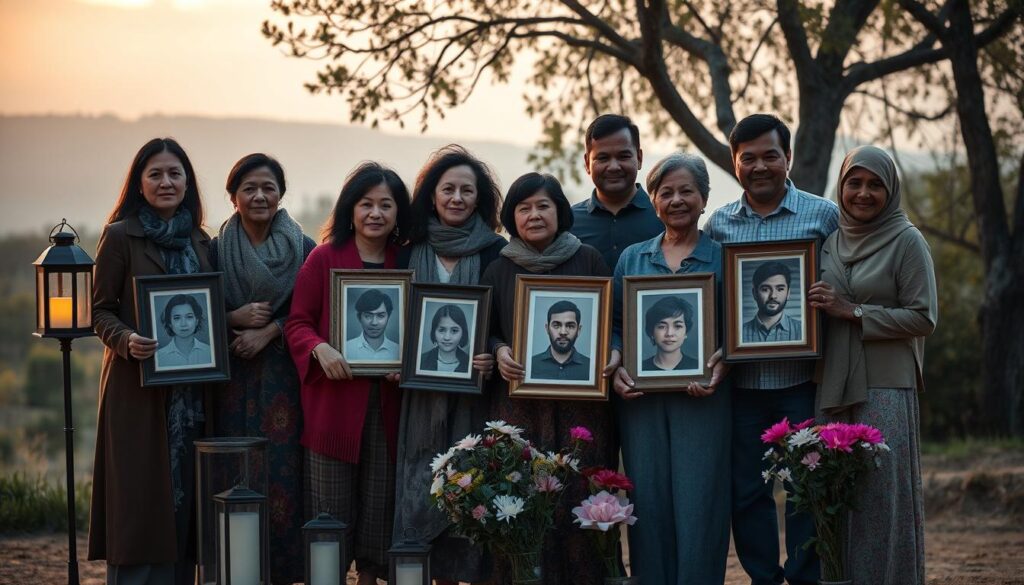

Documentation and Evidence Gathering Methods
Proper documentation and evidence gathering are key in missing persons cases. Keeping detailed records of all interactions with law enforcement and witnesses is vital. Investigators must also collect and preserve any potential evidence, like personal belongings or surveillance footage.
Witness accounts are very important for the investigation. It’s crucial to get detailed, accurate accounts from witnesses. Working closely with investigators to explore all leads can greatly help the search. Keeping a timeline of events and new information can also reveal important clues.
Forensic evidence, like DNA analysis and fingerprints, is crucial in identifying missing persons. Submitting evidence for forensic testing, especially through the FBI’s Next Generation Identification system, can solve cold cases. A thorough approach to documentation and evidence gathering increases the chances of solving missing persons cases.
Source Links
- https://www.nps.gov/orgs/1563/cold-cases.htm
- https://uncovered.com/unsolved-missing-persons-cases/
- https://missingpersonscenter.org/
- https://nfound.org/the-crisis-of-missing-persons-in-america-an-in-depth-examination/
- https://www.ojp.gov/pdffiles1/nij/jr000256.pdf
- https://cognitiveresearchjournal.springeropen.com/articles/10.1186/s41235-024-00597-z
- https://abcnews.go.com/US/72-hours-missing-persons-investigation-critical-criminology-experts/story?id=58292638
- https://www.prsar.org/someone-is-missing.html
- https://www.missingpersons.gov.au/report/investigation-process
- https://www.theiacp.org/sites/default/files/2018-08/MissingPersonsPolicy.pdf
- https://www.detectiveedu.org/missing-persons-investigations/
- https://www.bia.gov/service/mmu/national-missing-and-unidentified-persons-system-namus
- https://en.wikipedia.org/wiki/National_Missing_and_Unidentified_Persons_System
- https://www.veritone.com/blog/ai-public-safety-missing-persons/
- https://www.phenixinvestigations.com/intelligence-blog/using-private-investigators-to-track-down-missing-persons
- https://pmc.ncbi.nlm.nih.gov/articles/PMC7137422/
- https://lauthmissingpersons.com/missing-with-mental-illness/
- https://www.missingpersonsresearchhub.com/forfamiliesandlovedones
- https://rebekahslegacy.com/missing-person-resources
- https://missingpersons.icrc.org/families
- https://nij.ojp.gov/topics/articles/applying-modern-investigation-methods-solve-cold-cases
- https://www.phenixinvestigations.com/intelligence-blog/surveillance-in-missing-persons-cases-techniques-and-tools
- https://www.phenixinvestigations.com/intelligence-blog/understanding-the-role-of-private-investigators-in-missing-persons-cases
